Letters from Lodi
An insightful and objective look at viticulture and winemaking from the Lodi
Appellation and the growers and vintners behind these crafts. Told from the
perspective of multi-award winning wine journalist, Randy Caparoso.
Jessie’s Grove's Royal Tee field mix – Lodi’s oldest, most historic Zinfandel planting
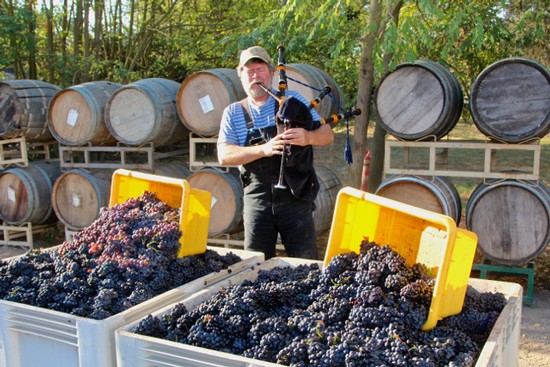
Alquimista's Greg La Follette heralding the 2015 harvest of Jessie's Grove's Royal Tee Vineyard
Jessie’s Grove Winery’s Royal Tee Vineyard is the Lodi Viticultural Area’s oldest existing Zinfandel planting; put into the (Tokay Series) fine sandy loam of Mokelumne River’s west side, on its own (Zinfandel) rootstocks, by Joseph Spenker in 1889. The vines were originally planted at the request of Stockton’s El Pinal Winery (which eventually closed during Prohibition) with cuttings supplied by the winery’s nursery.
The vineyard adds up to precisely 4.95 acres. The peculiar thing about the Royal Tee – at least for Lodi – is that only about 84.5% of the vineyard consists of Zinfandel. The rest of it is Carignan (about 10.5%), Flame Tokay (4%), Mission (.5%) and a rare, 19th century heirloom called Black Prince (.5%).

Lodi's once-ubiquitous, but now rare, Flame Tokay; on 129-year-old Royal Tee Vineyard vine
As such, Royal Tee Vineyard is not just any ol’ ancient vine planting. It is a living, breathing, thriving piece of winegrowing history. Between the 1860s and early 1900s, most California vintners believed red wines made from Zinfandel were improved by field mixes. A number of these historic mixed plantings still survive in Sonoma County and Napa Valley (for a good listing, see the register on the Historic Vineyard Society page). In Lodi, however, most of the vineyards planted prior to the early 1960s – the final era of own-rooted, head trained Zinfandel plantings in the region – were steadily manicured to the point where they were virtually pure Zinfandel, with almost no inter-plantings of other grape varieties (with the exception of a few strays).

129-year-old Zinfandel in Jessie's Grove's Royal Tee Vineyard
Here’s another fact that only Lodi old timers can now recall: Up until 1996, there were actually another 40 acres of this field mix, dominating the old Spenker Ranch property all the way out to W. Turner Rd., bordered on the east side by N. Davis Rd. (across the street from The Lucas Winery). Grower/owner Greg Burns, a direct descendant of Joseph Spenker, explains why the decision was made to tear out the old blocks – some of them pre-dating the existing Royal Tee Vineyard portion by one to three years – and replace them with the trellised Merlot and Chardonnay that you see today:
“There were parts of the old vineyard that were so decayed, some years they produced virtually no crop. It was like an old sequoia grove – absolutely stunning, giant, 6-foot Carignan, Mission and Tokay vines in amongst the Zinfandel – but really, there was almost no market for them.
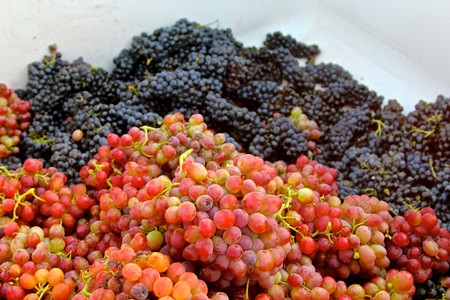
Alquimista's Royal Tee harvest; field mixing Flame Tokay and Zinfandel grapes
“Up until about 2000 we were primarily an E. & J. Gallo house. Before Gallo came along (by the late 1930s), fruit from the old vines were mostly packed for shipping back East. For many years we would simply pick the entire field and send all the grapes to the winery – Mission, Carignan, Zinfandel and all – but after a while we were forced to flag the Zinfandel vines because they insisted on only one grape. The rest of the field would go unpicked.
“Then in 1996, Turley Wine Cellars came along, and they chose what is now the Royal Tee block to produce three vintages of wine. We made the tough decision as a family to pull the rest of the old blocks out, and in 1998 we produced our own Jessie’s Grove Royal Tee Zinfandel for the first time.”
Laying out sample clusters of each of the five grapes planted in the Royal Tee Vineyard, Mr. Burns explained:
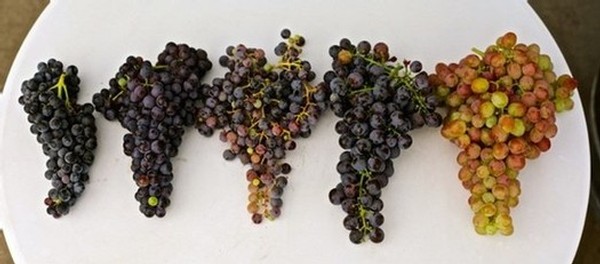
Royal Tee Vineyard grapes (from left): 1) Zinfandel; 2) Carignan; 3) Mission; 4) Black Prince; 5) Flame Tokay
“You can see and taste the unique character of each grape. Zinfandel produces the smallest berries and cluster; and even though it is not yet completely ripe (in mid-August 2018), you can already taste the jammy berry flavor and tannin structure that makes it such a beautiful wine.
“Carignan, on the other hand, is a larger cluster with medium sized berries. The taste is more like sour cherry. You can clearly see why Carignan was blended with Zinfandel – to give it that acidity.
“Mission is a long, very loose cluster of smaller berries. Its fruit is very soft tasting, and by itself, it would make a juicy, easy drinking wine with just a little tartness. But it can never be a very complex wine, which is why the old timers always preferred Zinfandel as the predominant grape.
“Finally, the Black Prince and Flame Tokay grapes, which have a table grape quality – big, generous clusters with soft fruit, crunchy seeds, big berries, great for eating. Before we started producing our Ancient Vine Tokay (a lightly fortified style of sweet dessert wine), we used to leave the Tokay out in the field for our workers to eat; which, of course, was why this grape was grown for so many years in Lodi.
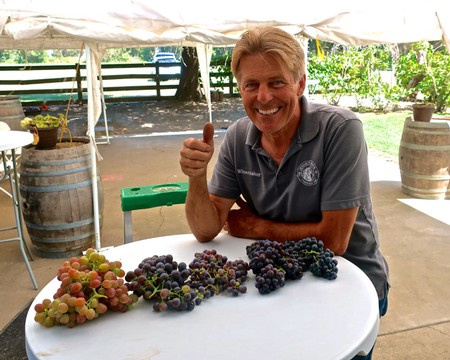
Jessie's Grove's Greg Burns with 2018 Royal Tee Vineyard cluster samples
“I think that back in 1889 winemakers intuitively knew that if you plant Zinfandel in a field mix you can get a fuller range of flavor profiles in a wine. Greg La Follette (winemaker/partner of Alquimista Cellars) has been making wine from all five varieties since 2015. I think he has proven that fermenting all five grapes together in their original proportions brings out the best in the vineyard.
“For Jessie’s Grove, we’ve been separating the Zinfandel out from the rest to produce our Royal Tee Vineyard Zinfandel. The Carignan has been going into our Ancient Vine Carignane bottlings, and our Tokay, of course, goes into our Ancient Vine Tokay. Last year (in 2017) I picked my own field blend for the first time, and it is a softer yet more complex wine; every bit as rich as our 100% Zinfandel, but different, as you would expect.”
Alquimista and Jessie’s Grove Royal Tee Zinfandels
Tasting notes on the two current releases crafted from the Royal Tee Vineyard:
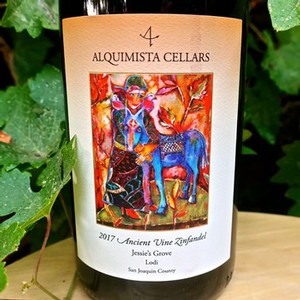
2017 Alquimista, Jessie’s Grove Lodi Zinfandel ($52) – Ethereal, almost flowery red fruit perfume (strawberry/cherry/raspberry) tinged with brown spices and the faintest earthy undertones; zesty, fine, silky sensations with a sense of real, almost un-Zinfandel-like finesse (like Pinot Noir with an even redder fruit profile) to its medium-weight body, belying the label’s stated alcohol (14.7%). If this 5-grape field blend is, in fact, the “real” face of Royal Tee Zinfandel – finally uncovered after well over 100 years – it is an irresistibly fine and delicate one.
2013 Jessie’s Grove, Royal Tee Vineyard Lodi Zinfandel ($45) – By way of stark contrast, a 100% Zinfandel seeing over 2 years of barrel age. Consequently, a deeper, jammier, fuller bodied interpretation (15.5% alcohol) of the vineyard; mildly herby and earthy, with slightly caramelized oak notes tinging the taste of blackberry, dried plum and fig in the nose and on the palate, which comes across as dense and fleshy-feeling.

To get an idea of Mr. La Follette’s thinking behind the 2017 Alquimista, we garnered a few comments over the phone earlier this week. According to La Follette:
“We started producing a Jessie’s Grove Zinfandel in 2015, so we’ll be picking our fourth vintage, maybe around September 9 (2018) or just after. Mara (Mr. La Follette’s wife) and I are really looking forward to it. Picking at Jessie’s Grove has really become a celebratory thing for us. It’s not just the vineyard, but Lodi which has become a special place for us.

Greg La Follette packing up a ton and a half of his first, limited picking (2015) of Royal Tee Vineyard
“We make our Alquimista Zinfandel semi-carbonically (re the carbonic maceration method of inducing intracellular fermention, which results in fruitier reds with very soft tannin). What I mean is, we take the whole clusters of Mission, Tokay and Black Prince and we don’t destem them. Instead, we put the clusters at the bottom of the fermentor, and then we bury them with the destemmed Zinfandel and Carignan. Because we don’t inoculate (i.e. opting for native yeasts already on the grape skins), the fermentation takes a while to take off, which allows for semi-carbonic activity.
“The main reason we do this is because Mission is a pink colored grape, not terribly big berried in its cluster architecture; and Black Prince is large enough in berry size that it doesn’t get good extraction, or much of a bouquet when handled as a red wine. And of course, Flame Tokay is not really a colored grape either. So we don’t look for extraction from those three grapes. What we really want is the ebullience and playfulness they can add to the wine.

Shawn Green (Jessie's Grove vineyard foreman) with giant Carignan in Royal Tee Vineyard
“In the 2017 you’ll notice just a hint of raspberry on the back-palate, as the wine lingers on your taste buds, and that’s coming from the semi-carbonic maceration. So we’re using each grape in the vineyard in a way we consider is best for them. There’s no use in trying to bust Mission, Tokay or Black Prince apart and try to get extract out of them – they’re not going to give you that. We’re using them for the playful, bright fruit quality they can bring to the table.
“What we’re really doing, in this way, is partner up with the vineyard and what it has to offer in its unique and special way. I believe it’s up to us to interpret its speech, to be able to understand what it really wants to be – because we’re not just making a Lodi Zinfandel, we’re making a wine from this particular vineyard, with its very unique set of circumstances and grapes. Kind of like not shoving a round pick into a square hole.
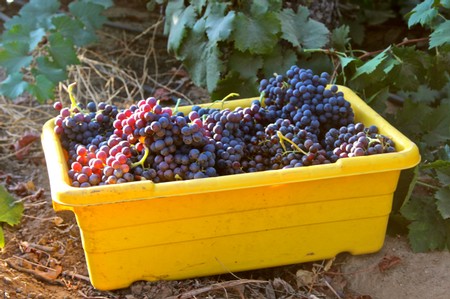
Royal Tee Vineyard Zinfandel harvest
“The result is something a little different. One of the restaurants that has embraced the wine is Single Thread in Healdsburg, Sonoma County. Single Thread is a truly profound and celebrated restaurant – recently ranked among the Top 50 in the world. They think the Jessie’s Grove Zinfandel is so unique, they actually designed a course specifically around it.
“The great thing about old vines like Jessie’s Grove’s is they really know their business. They’re pretty self-regulating, and it’s really up to us to trust that they know what they’re doing. I think Greg Burns is really good at that – as the years go by he’s gained more and more of an understanding of the vineyard, which comes from listening to what the vines themselves have to say.
“It’s like what my grandpa used to say, ‘Plant your corn early.’ Now, I was never sure exactly what that meant, but it always sounded wise; and it basically told me, always go with the flow!”

Harvest under rising September sun in Royal Tee Vineyard